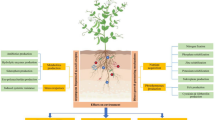Abstract
ALTHOUGH considerable information is available on the rhizosphere microflora and the influence of plants on this population, relatively little is known, of the effects of these micro-organisms on the host plant apart from organisms such as Rhizobium spp., plant pathogens and mycorrhizas. It has been shown that root growth can be affected by the filtrates of cultures of rhizosphere organisms1 and some antibiotic substances (polymyxin2, streptomycin and griseofulvin3); however, in all these cases the products of microbial growth rather than the micro-organisms themselves have been added to the roots.
This is a preview of subscription content, access via your institution
Access options
Subscribe to this journal
Receive 51 print issues and online access
$199.00 per year
only $3.90 per issue
Buy this article
- Purchase on Springer Link
- Instant access to full article PDF
Prices may be subject to local taxes which are calculated during checkout
Similar content being viewed by others
References
Stolp, H., Arch. Mikrobiol., 17, 1 (1952).
Norman, A. G., Arch. Biochem. Biophys., 58, 461 (1955).
Wright, Joyce M., Ann. Bot., N.S., 15, 493 (1951).
Hoagland, D. R., and Arnon, D. I., Univ. Calif. Agric. Expt. Sta. Circ., 347 (1938).
Author information
Authors and Affiliations
Rights and permissions
About this article
Cite this article
ROVIRA, A., BOWEN, G. Effect of Micro-Organisms on the Development of Roots and Root Hairs of Subterranean Clover (T. subterraneum). Nature 185, 260–261 (1960). https://doi.org/10.1038/185260a0
Issue Date:
DOI: https://doi.org/10.1038/185260a0
This article is cited by
-
Einflu� von Mikrofloren verschiedener B�den und von Bakterienreinkulturen auf das Pflanzenwachstum
Archiv f�r Mikrobiologie (1963)
-
Der Einflu� der Bodenmikroorganismen auf Trockensubstanzbildung und Aschegehalt in N�hrl�sung wachsender Pflanzen
Archiv f�r Mikrobiologie (1962)
-
Non-Lethal Pathological Infection of Roots
Nature (1961)
-
The effects of micro-organisms on plant growth
Plant and Soil (1961)
Comments
By submitting a comment you agree to abide by our Terms and Community Guidelines. If you find something abusive or that does not comply with our terms or guidelines please flag it as inappropriate.



